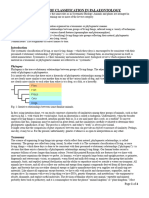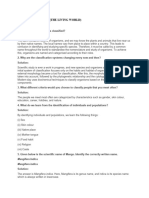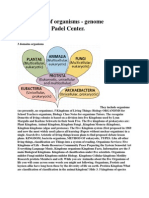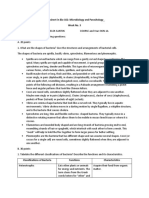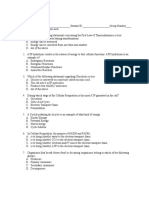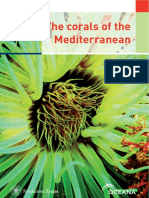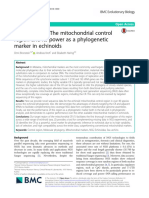Living World Ncert Soln
Living World Ncert Soln
Uploaded by
kevxin.johnCopyright:
Available Formats
Living World Ncert Soln
Living World Ncert Soln
Uploaded by
kevxin.johnOriginal Title
Copyright
Available Formats
Share this document
Did you find this document useful?
Is this content inappropriate?
Copyright:
Available Formats
Living World Ncert Soln
Living World Ncert Soln
Uploaded by
kevxin.johnCopyright:
Available Formats
1 The Living World
1. Why are living organisms classified?
Soln. Living organisms are classified because of the following reasons:
(i) Easy identification.
(ii)Study of organisms of other places.
(iii)Study of fossils
(iv)Grouping helps in study of all types of organisms while it is impossible to study
individually all of them.
(v) Itbringsoutsimilaritiesanddissimilarities. They help in knowing relationships among
different groups.
(vi)Evolution of various taxa can be known.
2. Why are the classification systems changing every now and then?
Soln. From very early days till now biologists use several characters for classification
system. These are morphology, anatomy, cytology, physiology, ontogeny, phylogeny,
reproduction, biochemistry, etc. But day by day biologists are learning something new
about organisms from their fossil records and using” advanced study techniques such
as molecular phylogeny, etc. So their point of view about classification keeps changing.
Thus the system of classification is modified every now and then.
3. What different criteria would you choose to classify people that you meet often?
Soln. The various criteria that may be chosen to classify people whom we meet often
include behaviour, geographical location, morphology, family members, relatives,
friends etc.
4. What do we learn from identification of individuals and populations?
Soln. The knowledge of characteristic of an individual or its whole population helps in
identification of similarities and dissimilarities among the individuals of same kind or
between different types of organisms. It helps us to classify the organisms in various
categories depending upon these similarities and dissimilarities.
5. Given below is the scientific name of mango. Identify the correctly written name.
Mangifera Indica Mangifera indica
Soln. The correctly written scientific name of mango is Mangifera indica.
6. Define a taxon. Give some example of taxa at different hierarchical levels.
Slon. A taxonomic unit in the biological system of classification of organism is called
taxon (plural taxa). For example a phylum, order, family, genus or species represents
taxon. It represents a rank. For example, all the insects form a taxon. Taxon of class
category for birds is Aves and taxon of Phylum category for birds is Chordata. The
degree of relationship and degree of similarity varies with the rank of the taxon.
Individuals of a higher rank, say Order or Family, are less closely related than those of a
lower rank, such as Genus or Species.
7. Can you identify the correct sequence of taxonomical categories?
(a) Species —> Order —> Phylum —> Kingdom
(b) Genus—) Species—> OrderKingdom
(c) Species —> Genus —>Order —> Phylum
Slon. The correct sequence of taxonomical categories is
(c) i.e., Species —>Genus —> Order —> Phylum.
8. Try to collect all the currently accepted meanings for the word ‘species’. Discuss
with your teacher the meaning of species in case of higher plants and animals on one
hand, and bacteria on the other hand.
Slon. Species occupies a key position in classification. It is the lowest taxonomic
category. It is a natural population of individuals or group of populations which
resemble one another in all essential morphological and reproductive characters so that
they are able to interbreed freely and produce fertile offsprings. Each species is also
called genetically distinct and reproductively isolated natural population. Mayr (1964)
has defined species as “a group of actually or potentially interbreeding populations that
are reproductively isolated from other such groups”.
In higher plants and animals the term ‘species’ refers to a group of individuals that are able to
interbreed freely and produce fertile offsprings. But, in case of bacteria interbreeding cannot
serve as the best criteria for delimiting species because bacteria usually reproduce asexually.
Conjugation, transformation and transduction, which are termed as sexual reproduction
methods in bacteria, also do not correspond to true interbreeding. Thus, for bacteria many other
characters such as molecular homology, biochemical, physiological, ecological and
morphological characters are taken into consideration while classifying them.
9. Define and understand the following terms:
(i) Phylum (ii) Class (iii) Family
(iv) Order (v) Genus
Slon. (i) Phylum – Phylum is a category higher than that of Class. The term Phylum is
used for animals. A Phylum is formed of one or more classes, e.g., the Phylum Chordata
of animals contains not only the class Mammalia but also Aves (birds), Reptilia
(reptiles), Amphibia (amphibians), etc. In plants the term Division is used in place of
Phylum.
(ii) Class – A Class is made of one or more related Orders. For example, the Class
Dicotyledoneae of flowering plants contains all dicots which are grouped into several
orders (e.g., Rosales, Sapindales, Ranales, etc.).
(iii) Family, – It is a taxonomic category which contains one or more related genera. All
the genera of a family have some common features or correlated characters. They are
separable from genera of a related family by important and characteristic differences in
both vegetative and reproductive features. E.g., the genera of cats (Fells) and leopard
(Panthera) are included in the Family Felidae. The members of Family Felidae are quite
distinct from those of Family Canidae (dogs, foxes, wolves).
Similarly, the family Solanaceae contains a number of genera like Solanum, Datura, Petunia and
Nicotiana. They are distinguishable from the genera of the related family Convolvulaceae
(Convolvulus, Ipomoea).
(iv) Order – The category includes one or more related families. E.g., the plant Family
Solanaceae is placed in the Order Polemoniales alongwith four other related families
(Convolvulaceae, Boraginaceae, Hydrophyllaceae and Polemoniaceae). Similarly, the animal
families Felidae and Canidae are included under the Order Carnivora alongwith Hyaenidae
(hyaenas) and Ursidae (bears).
(v) Genus – It is a group or assemblage of related species which resemble one another in
certain correlated characters. Correlated characters are those similar or common features
which are used in delimitation of a taxon above the rank of species. All the species of genus are
presumed to have evolved from a common ancestor. A genus may have a single living species
e.g., Genus Homo. Its species is Homo sapiens – the living or modem man. The Genus Felis has
many species, e.g., F. domestica – common cat, F. chaus (jungle cat) etc.
lO.How is a key helpful in the identification and classification of an organism?
Slon.‘Key is an artificial analytic device having a list of statements with dichotomic table
of alternate characteristics. Taxonomic
keys are aids for rapid identification of unknown plants and animals based on
the similarities and dissimilarities. Keys are primarily based on stable and reliable
characters. The keys are helpful in a faster preliminary identification which can
bebacked up by confirmation through comparison with detailed description of the taxon
provisionally identified with. Separate taxonomic keys are used for each taxonomic
category like Family, Genus and Species.
11.Illustrate the taxonomical hierarchy with suitable examples of a plant and an
animal.
Slon. The arrangement of various taxa in a hierarchical order is called taxonomic
hierarchy. The hierarchy indicates the various levels of kinship. The number of similar
characters of categories decreases from lowest rank to highest rank. The hierarchical
system of classification was introduced by Linnaeus.
The hierarchy of major categories is:
Species —►Genus-►Family —► Order—► Class
Kingdom -4— Phylum or Division
Increasing specificity – ► Decreasing specificity
Classification of a plant (Wheat):
Kingdom – Plantae
Division – Angiospermae
Class – Monocotyledonae
Order – Poales
Family – Poaceae
Genus – Triticum
Species – aestivum
Classification of an animal (Housefly):
Kingdom – Animalia
Phylum – Chordata
Class – Insecta
Order – Diptera
Family – Muscidae
Genus – Musca
Species – domestica
You might also like
- Biology Textbook Answers Chapter 1 To 4No ratings yetBiology Textbook Answers Chapter 1 To 423 pages
- NCERT Solutions For Biology Chapter 1 The Living World Class 11No ratings yetNCERT Solutions For Biology Chapter 1 The Living World Class 116 pages
- A. Biological Classification - BIOLOGY4ISCNo ratings yetA. Biological Classification - BIOLOGY4ISC1 page
- Biology Why Are Living Organisms Classified?: AnswerNo ratings yetBiology Why Are Living Organisms Classified?: Answer35 pages
- NCERT Solutions For Class 11 Biology Chapter 1 - The Living World - .No ratings yetNCERT Solutions For Class 11 Biology Chapter 1 - The Living World - .5 pages
- NCERT Solutions Class 11 Biology Chapter 1No ratings yetNCERT Solutions Class 11 Biology Chapter 13 pages
- Taxonomy - Importance, History and Development and Binomial Nomenclature - Definitions of Biotype, Sub-Species, Species, Genus, Family and OrderNo ratings yetTaxonomy - Importance, History and Development and Binomial Nomenclature - Definitions of Biotype, Sub-Species, Species, Genus, Family and Order4 pages
- 0 111116 1.3Classificationandspecies (2)No ratings yet0 111116 1.3Classificationandspecies (2)13 pages
- Kunal-575) Systems of Classification - KunalNo ratings yetKunal-575) Systems of Classification - Kunal8 pages
- Ncert Solutions Class 11 Biology Chapter 1 The Living World - 0No ratings yetNcert Solutions Class 11 Biology Chapter 1 The Living World - 07 pages
- Biology Module Melc 10 Chjaracteristics Os Specific TaxonNo ratings yetBiology Module Melc 10 Chjaracteristics Os Specific Taxon7 pages
- Principles of Classification in PalaeontologyNo ratings yetPrinciples of Classification in Palaeontology4 pages
- Taxonomy Phylogenetic Tree and Cladistics DISCUSSIONNo ratings yetTaxonomy Phylogenetic Tree and Cladistics DISCUSSION43 pages
- Science 8 Q4 WK4 Naming and Classififying Organism 1.CQA.gqa.LRQA EDITEDNo ratings yetScience 8 Q4 WK4 Naming and Classififying Organism 1.CQA.gqa.LRQA EDITED14 pages
- Efektifitas Fungi Mikoriza Arbuskula (Fma) Serta Pupuk Nitrogen Dan Fosfat Terhadap PERTUMBUHAN SEMAI JABON (Anthocephallus Cadamba Roxb.)No ratings yetEfektifitas Fungi Mikoriza Arbuskula (Fma) Serta Pupuk Nitrogen Dan Fosfat Terhadap PERTUMBUHAN SEMAI JABON (Anthocephallus Cadamba Roxb.)6 pages
- Worksheet in Bio 102: Microbiology and Parasitology - Week No. 3No ratings yetWorksheet in Bio 102: Microbiology and Parasitology - Week No. 34 pages
- Organisms That Break Down Dead or Decaying Organisms100% (1)Organisms That Break Down Dead or Decaying Organisms9 pages
- Study of Ecosystem of Uttarakhand and KarnatakaNo ratings yetStudy of Ecosystem of Uttarakhand and Karnataka3 pages
- Organic Component of Haemolymph in The Male Millipede, Mordanius Importatus and Effect of Temperature On ItNo ratings yetOrganic Component of Haemolymph in The Male Millipede, Mordanius Importatus and Effect of Temperature On It2 pages
- B. Sample Multiple Choice Questions: Genetics Review100% (1)B. Sample Multiple Choice Questions: Genetics Review8 pages
- Diversity of Insect Intestinal Microflora PDFNo ratings yetDiversity of Insect Intestinal Microflora PDF6 pages
- Dr. IGA Wiradari T, SP - PK: Laboratorium Klinik DiagnosNo ratings yetDr. IGA Wiradari T, SP - PK: Laboratorium Klinik Diagnos1 page
- Binayak Science College +2 1 Year ScienceNo ratings yetBinayak Science College +2 1 Year Science1 page
- 20 Permanent Flowering Plants in India That Live All Year (Perennials)No ratings yet20 Permanent Flowering Plants in India That Live All Year (Perennials)1 page
- NCERT Solutions For Biology Chapter 1 The Living World Class 11NCERT Solutions For Biology Chapter 1 The Living World Class 11
- Biology Why Are Living Organisms Classified?: AnswerBiology Why Are Living Organisms Classified?: Answer
- NCERT Solutions For Class 11 Biology Chapter 1 - The Living World - .NCERT Solutions For Class 11 Biology Chapter 1 - The Living World - .
- Taxonomy - Importance, History and Development and Binomial Nomenclature - Definitions of Biotype, Sub-Species, Species, Genus, Family and OrderTaxonomy - Importance, History and Development and Binomial Nomenclature - Definitions of Biotype, Sub-Species, Species, Genus, Family and Order
- Ncert Solutions Class 11 Biology Chapter 1 The Living World - 0Ncert Solutions Class 11 Biology Chapter 1 The Living World - 0
- Biology Module Melc 10 Chjaracteristics Os Specific TaxonBiology Module Melc 10 Chjaracteristics Os Specific Taxon
- Taxonomy Phylogenetic Tree and Cladistics DISCUSSIONTaxonomy Phylogenetic Tree and Cladistics DISCUSSION
- Science 8 Q4 WK4 Naming and Classififying Organism 1.CQA.gqa.LRQA EDITEDScience 8 Q4 WK4 Naming and Classififying Organism 1.CQA.gqa.LRQA EDITED
- Efektifitas Fungi Mikoriza Arbuskula (Fma) Serta Pupuk Nitrogen Dan Fosfat Terhadap PERTUMBUHAN SEMAI JABON (Anthocephallus Cadamba Roxb.)Efektifitas Fungi Mikoriza Arbuskula (Fma) Serta Pupuk Nitrogen Dan Fosfat Terhadap PERTUMBUHAN SEMAI JABON (Anthocephallus Cadamba Roxb.)
- Worksheet in Bio 102: Microbiology and Parasitology - Week No. 3Worksheet in Bio 102: Microbiology and Parasitology - Week No. 3
- Organisms That Break Down Dead or Decaying OrganismsOrganisms That Break Down Dead or Decaying Organisms
- Organic Component of Haemolymph in The Male Millipede, Mordanius Importatus and Effect of Temperature On ItOrganic Component of Haemolymph in The Male Millipede, Mordanius Importatus and Effect of Temperature On It
- B. Sample Multiple Choice Questions: Genetics ReviewB. Sample Multiple Choice Questions: Genetics Review
- Dr. IGA Wiradari T, SP - PK: Laboratorium Klinik DiagnosDr. IGA Wiradari T, SP - PK: Laboratorium Klinik Diagnos
- 20 Permanent Flowering Plants in India That Live All Year (Perennials)20 Permanent Flowering Plants in India That Live All Year (Perennials)











































